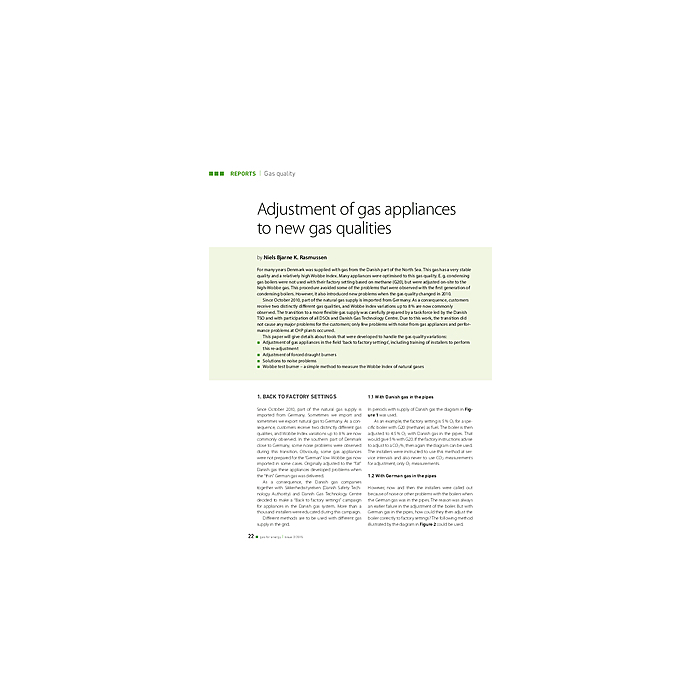Adjustment of gas appliances to new gas qualities
4,90 €
Auf Lager
Artikelnummer
00258_2015_02_01
For many years Denmark was supplied with gas from the Danish part of the North Sea. This gas has a very stable quality and a relatively high Wobbe Index. Many appliances were optimised to this gas quality. E. g. condensing gas boilers were not used with their factory setting based on methane (G20), but were adjusted on-site to the high-Wobbe gas. This procedure avoided some of the problems that were observed with the first generation of condensing boilers. However, it also introduced new problems when the gas quality changed in 2010. Since October 2010, part of the natural gas supply is imported from Germany. As a consequence, customers receive two distinctly different gas qualities, and Wobbe Index variations up to 8 % are now commonly observed. The transition to a more flexible gas supply was carefully prepared by a task force led by the Danish TSO and with participation of all DSOs and Danish Gas Technology Centre. Due to this work, the transition did not cause any major problems for the customers; only few problems with noise from gas appliances and performance problems at CHP plants occurred. This paper will give details about tools that were developed to handle the gas quality variations: Adjustment of gas appliances in the field ‘back to factory settings’, including training of installers to perform this re-adjustment; Adjustment of forced draught burners; Solutions to noise problems; Wobbe test burner – a simple method to measure the Wobbe Index of natural gases
| Autoren | Niels Bjarne K. Rasmussen |
|---|---|
| Erscheinungsdatum | 01.02.2015 |
| Format | |
| Zeitschrift | gas for energy - Ausgabe 02 2015 |
| Verlag | DIV Deutscher Industrieverlag GmbH |
| Sprache | English |
| Titel | Adjustment of gas appliances to new gas qualities |
| Beschreibung | For many years Denmark was supplied with gas from the Danish part of the North Sea. This gas has a very stable quality and a relatively high Wobbe Index. Many appliances were optimised to this gas quality. E. g. condensing gas boilers were not used with their factory setting based on methane (G20), but were adjusted on-site to the high-Wobbe gas. This procedure avoided some of the problems that were observed with the first generation of condensing boilers. However, it also introduced new problems when the gas quality changed in 2010. Since October 2010, part of the natural gas supply is imported from Germany. As a consequence, customers receive two distinctly different gas qualities, and Wobbe Index variations up to 8 % are now commonly observed. The transition to a more flexible gas supply was carefully prepared by a task force led by the Danish TSO and with participation of all DSOs and Danish Gas Technology Centre. Due to this work, the transition did not cause any major problems for the customers; only few problems with noise from gas appliances and performance problems at CHP plants occurred. This paper will give details about tools that were developed to handle the gas quality variations: Adjustment of gas appliances in the field ‘back to factory settings’, including training of installers to perform this re-adjustment; Adjustment of forced draught burners; Solutions to noise problems; Wobbe test burner – a simple method to measure the Wobbe Index of natural gases |
Eigene Bewertung schreiben


